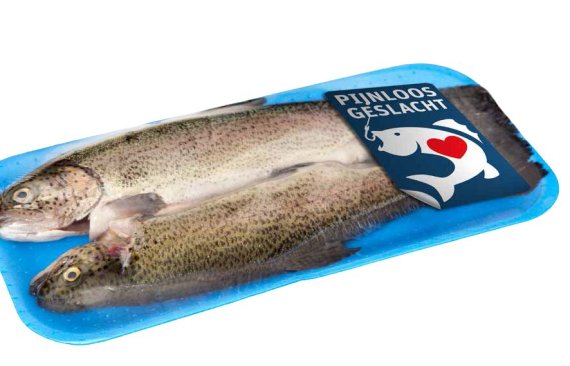According to the Wakker Dier campaigners, fish such as herring, plaice and cod suffer terribly during slaughter. But it is not entirely certain whether fish feel pain, say researchers Hans van de Vis (Imares) and Marien Gerritzen (Livestock Research). They have been doing research on the stunning of fish since 1997. Gerritzen has done a lot of research on farm animals such as pigs and chickens, too. Just like humans, they have a central nervous system in which pain is registered and experienced in the brain. But fish have a very different brain structure, without a prefrontal cortex. For this reason, some research groups (a minority) believe fish cannot feel pain. Other groups (a majority) believe that fish feel pain in a different way than we do. ‘We do not know much about fish brains,’ says Van de Vis, summarizing the situation.
Yet we can assume that fish feel pain. Research on the behaviour and neurophysiology of fish has thrown up evidence that fish have consciousness and can therefore experience events as positive or negative. You can therefore teach fish new behaviour. If you repeatedly flash a light shortly before feeding cod, the fish come to expect to be fed. A cod can remember that connection for three months. Another study shows that fish interact, showing behaviour that suggests an order of rank. Moreover, stunned fish respond differently to a stimulus than conscious fish, and you can measure the differences in brain activity, says Van de Vis. Taken together, these are strong indications that fish do experience pain.
So Gerritzen and Van de Vis are doing research on the stunning of fish before slaughter. They have about 20 publications to their name about fish such as eel, sole, salmon and African catfish. ‘We started from scratch. We developed the apparatus for stunning fish ourselves.’ The researchers also helped develop the method of measuring: they measure the brain activity of fish using EEG. They are pioneers with this method in Europe. They were able, for instance, to demonstrate that stunning eels with an electric shock rendered the fish unconscious, just as it does with chickens.
If one thing has become clear in the course of their research, it is that not all fish are the same. Eel and African catfish are very different, and so are salmon and sole. Their brains are different and their habitats too. So every fish requires a different approach and stunning technique, just as you cannot treat pigs and chickens in the same way. You also need to bear in mind the way fisheries operate. There are different requirements for stunning fish out at sea, where the catch comes out of a big net, than for stunning farmed fish on the conveyor belt in a slaughterhouse on land.
The on-board stunning process involves the fish moving over a negatively charged belt where they come in contact with positively charged spoons which stun them.
Nowadays most farmed fish in the Netherlands is stunned before slaughter. For eel and African catfish, which account for 90 percent of Dutch farmed fish, a good method has been developed for stunning the fish during the slaughter process. The trend can be seen in other European countries as well. In Norway and England, most salmon is stunned before slaughter, either because of legislation or because the supermarkets demand it. Most trout is stunned too, but there are no good methods yet of stunning sea bass and sea bream. Gerritzen and Van de Vis’s colleagues in Spain are looking for methods of developing pain- and stress-free slaughter methods for these fish too.
Wild sea fish such as herring, cod and plaice, however, are still slaughtered without prior stunning. In order to establish specifications for them, Gerritzen and Van de Vis are working on the research project ‘On-board stunning’. At the behest of the ministry of Economic Affairs and in collaboration with initiator Ekofish – a fish company from Urk – and advisory bureau Scienta Nova, they seek to develop an electric stunner that can stun plaice, dab and sole outright. The electric shock needs to be sufficient to render the fish unconscious but not strong enough to cause bruising and make the fish unmarketable. What is more, the apparatus must be safe for the fishers to handle and be able to process a lot of fish in a short time.
Theoretically, there are four ways of stunning the fish, just as there are in livestock farming: electric shock treatment, a blow to the head, gassing or using a bolt pistol to render the fish brain-dead. Currently electricity seems the best option for stunning the fish on-board. The difficulty is, however, that you need to deal with different species of fish of different sizes and ages at the same time.
This applied research is not finished yet, and has not yet produced a well-developed method of stunning fish at sea, says Van de Vis. Moreover, the results of this study only apply to flatfish. For other North Sea fish species, such as herring and cod, no studies have yet been done on the possibilities for stunning at sea. And you cannot just transfer the findings from research on plaice, say Van de Vis and Gerritzen. ‘To stun a cod outright you need 52 volts, and for a salmon you need 108 volts. Those are big differences. What is more, the results depend on the conditions on board.’ So more research will be needed before our Dutch herring can be stunned on board prior to slaughter.


